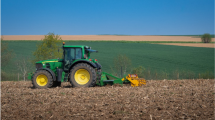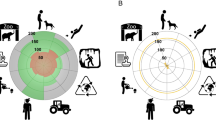Abstract
Using Local Ecological Knowledge to Assess Morel Decline in the U.S. Mid–Atlantic Region. Morels (Morchella spp.) are prized wild edible mushrooms. In the United States, morels are the focus of family traditions, local festivals, mycological society forays, and social media, as well as substantial commercial trade. A majority of the anglophone research on morels has been conducted in Europe and in the U.S. Pacific Northwest and Midwest. This literature provides insights into a diverse and plastic genus, but much of its biology and ecology remains a mystery. In 2004, we initiated a study of morel mushroom harvesting in the U.S. Mid–Atlantic region in response to concerns that morels might be in decline in the national parks in that area. This paper presents results from that research with an emphasis on morel hunters’ local ecological knowledge of morel types, phenology, habitat, vegetative associations, and responses to disturbance. We conclude that experienced morel harvesters possess local ecological knowledge that complements scientific knowledge and can increase our understanding of the complex and regionally variable ecology of Morchella and inform conservation efforts.





Similar content being viewed by others
Literature Cited
Agrawal, A. 1995. Indigenous and Scientific Knowledge: Some Critical Comments. Indigenous Knowledge and Development Monitor 3:3–6.
Aleksic, N., K. Roy, G. Sistla, J. Dukett, N. Houck, and P. Casson. 2009. Analysis of Cloud and Precipitation Chemistry at Whiteface Mountain, NY. Atmospheric Environment 43:2709–2716.
Anderson, M. K. 1996. Tending the Wilderness. Restoration & Management Notes 14:154–166.
Baker, J. 2010. Land Cover Change in Maryland. Personal communication to E. S. Barron, ed., New Brunswick, New Jersey.
Ballard, H. L. and L. Huntsinger. 2006. Salal Harvester Local Ecological Knowledge, Harvest Practices and Understory Management on the Olympic Peninsula, Washington. Human Ecology 34:529–547.
———, M. E. Fernandez–Gimenez, and V. E. Sturtevant. 2008. Integration of Local Ecological Knowledge and Conventional Science: A Study of Seven Community–Based Forestry Organizations in the USA. Ecology and Society 13.
Barron, E. S. and M. R. Emery. 2009. Page 58 Protecting Resources: Assessing Visitor Harvesting of Wild Morel Mushrooms in Two National Capital Region Parks. National Park Service, Washington, D.C.
Berkes, F. 1999. Sacred Ecology: Traditional Ecological Knowledge and Resource Management. Taylor & Francis, Philadelphia.
———, J. Colding, and C. Folke. 2000. Rediscovery of Traditional Ecological Knowledge as Adaptive Management. Ecological Applications 10:1251–1262.
Borer, C. H., P. G. Schaberg, and D. H. DeHayes. 2005. Acidic Mist Reduces Foliar Membrane–Associated Calcium and Impairs Stomatal Responsiveness in Red Spruce. Tree Physiology 25:673–680.
Buscot, F. 1994. Ectomycorrhizal Types and Endobacteria Associated with Ectomycorrhizas of Morchella elata (Fr.) Boudier with Picea abies (L.) Karst. Mycorrhiza 4:223–232.
Dewsbury, D. R. and J–. M. Moncalvo. 2007. A Molecular Phylogeny of Eastern North American Morels (genus Morchella) Focusing on the “Carolinian” Forest Zone. Mycological Society of America, Hilo, Hawaii.
Egli, S., M. Peter, C. Buser, W. Stahel, and F. Ayer. 2006. Mushroom Picking Does Not Impair Future Harvests—Results of a Long–Term Study in Switzerland. Biological Conservation 129:271–276.
Emery, M. R. 1998. Invisible Livelihoods: Non–Timber Forest Products in Michigan’s Upper Peninsula. UMI Dissertation Services, Ann Arbor, Michigan.
——— 2001. Who Knows? Local Non–Timber Forest Product Knowledge and Stewardship Practices in Northern Michigan. Journal of Sustainable Forestry 13:123–139.
Fine, G. A. 2003. Morel Tales: The Culture of Mushrooming. University of Illinois Press, Urbana, Illinois.
Hufford, M. 2006. Molly Mooching on Bradley Mountain: The Aesthetic Ecology of Appalachian Morels. Gastronomica:49–56.
Huntington, H. P. 2000. Using Traditional Ecological Knowledge in Science: Methods and Applications. Ecological Applications 10:1270–1274.
Kellner, H., C. Renker, and F. Buscot. 2005. Species Diversity within the Morchella Esculenta Group (Ascomycota: Morchellaceae) in Germany and France. Organisms Diversity & Evolution 5:101–107.
Kimmerer, R. W. 2000. Native Knowledge for Native Ecosystems. Journal of Forestry 98:4–9.
Kuo, M. 2005. Morels. University of Michigan Press, Ann Arbor, Michigan.
——— 2008. Morchella tomentosa, A New Species from Western North America, and Notes on M. rufobrunnea. Mycotaxon 105:441–446.
Lawrence, G. B., K. M. Roy, B. P. Baldigo, H. A. Simonin, S. B. Capone, J. W. Sutherland, J. W. Sutherland, S. A. Nierzwicki–Bauer, and C. W. Boylen. 2008. Chronic and Episodic Acidification of Adirondack Streams from Acid Rain in 2003–2005. Journal of Environmental Quality 37:2264–2274.
Long, B. 2007. Maryland Game Program 2006–2007 Annual Report. Wildlife and Heritage Service, Maryland Department of Natural Resources, Annapolis, Maryland.
Low, J. 1995. Missouri’s Magnificent Morels. Missouri Conservationist 56:20–23.
McLain, R. 2008. Constructing a Wild Mushroom Panopticon: The Extension of Nation–State Control over the Forest Understory in Oregon, USA. Economic Botany 62:343–355.
Moller, H., F. Berkes, P. O. B. Lyver, and M. Kislalioghu. 2004. Combining Science and Traditional Ecological Knowledge: Monitoring Populations for Co–Management. Ecology and Society 9:2.
Moore, D., M. M. Nauta, S. E. Evans, and M. Rotheroe. 2001. Fungal Conservation Issues: Recognizing the Problem, Finding Solutions. Pages 1–6 in D. Moore, M. M. Nauta, S. E. Evans, and M. Rotheroe, eds., Fungal Conservation: Issues and Solutions. Cambridge University Press, Cambridge, U.K.
Morels.com. 2009. Morels World Wide. North Guide. http://morels.com (16 October 2009).
National Climatic Data Center. 2009a. Climate at a Glance: Spring (Mar–May) Temperature Maryland. Page Dynamically Generated Graph. National Climate Data Center, National Oceanic and Atmospheric Administration.
———. 2009b. Climate at a Glance: Winter (Dec–Feb) Temperature Maryland. National Climate Data Center, National Oceanic and Atmospheric Administration.
———. 2009c. Climate at a Glance: Winter (Dec–Feb) Precipitation Maryland. National Climate Data Center, National Oceanic & Atmospheric Administration.
Norvell, L. 1995. Loving the Chanterelle to Death? The Ten–Year Oregon Chanterelle Project. McIlvainea 12:6–25.
O’Donnell, K., N. S. Weber, S. Rehner, and G. Mills. 2003. Phylogeny and Biogeography of Morchella. Fungal Genetics Conference, Pacific Grove, California.
Olsson, P. and C. Folke. 2001. Local Ecological Knowledge and Institutional Dynamics for Ecosystem Management: A Study of Lake Racken Watershed, Sweden. Ecosystems 4:85–104.
Patton, M. Q. 2002. Qualitative Research & Evaluation Methods. Sage Publications, Thousand Oaks, California.
Peacock, S. L. and N. J. Turner. 2000. “Just Like A Garden”: Traditional Resource Management and Biodiversity Conservation on the Interior Plateau of British Columbia. Pages 133–179 in P. E. Minnis and W. J. Elisens, eds., Biodiversity and Native America. University of Oklahoma Press, Norman, Oklahoma.
Pierotti, R. and D. Wildcat. 2000. Traditional Ecological Knowledge: The Third Alternative (Commentary). Ecological Applications 10:1333–1340.
Pilz, D., H. L. Ballard, and E. T. Jones. 2006. Page 131 Broadening Participation in Biological Monitoring: Handbook for Scientists and Managers. Pacific Northwest Research Station General Technical Report. U.S. Department of Agriculture, Forest Service. Pacific Northwest Research Station, Portland, Oregon.
———, R. McLain, S. Alexander, L. Villarreal–Ruiz, S. Berch, T. L. Wurtz, C. G. Parks, E. McFarlane, B. Baker, R. Molina, and J. E. Smith. 2007. Page 161 Ecology and Management of Morels Harvested from the Forests of Western North America. U.S. Department of Agriculture, Forest Service. Pacific Northwest Research Station, Portland, Oregon.
QSR International. 2006. NVivo 7.0. QSR International: Cambridge, MA.
Roth, R. 2004. Spatial Organization of Environmental Knowledge: Conservation Conflicts in the Inhabited Forest of Northern Thailand. Ecology and Society 9.
Roux, D. J., K. H. Rogers, H. C. Biggs, P. J. Ashton, and A. Sergeant. 2006. Bridging the Science–Management Divide: Moving from Unidirectional Knowledge Transfer to Knowledge Interfacing and Sharing. Ecology and Society 11.
Social Science Data Analysis Network. 2008. CensusScope. University of Michigan, Ann Arbor, Michigan.
Thompson, V. V. 1994. Page 36 Morel: A Lifetime Pursuit. Missouri Mycological Society, Glencoe, Missouri.
Ticktin, T. and T. Johns. 2002. Chinanteco Management of Aechmea magdalenae: Implications for the Use of TEK and TRM in Management Plans. Economic Botany 56:177–191.
Turner, N. J. and F. Berkes. 2006. Coming to Understanding: Developing Conservation through Incremental Learning in the Pacific Northwest. Human Ecology 34:495–513.
Watling, R. 2005. Fungal Conservation: Some Impressions—A Personal View. Page 936 in J. Dighton, J. F. White, and P. Oudemans, eds., The Fungal Community: Its Organization and Role in the Ecosystem. Taylor & Francis/CRC Press, Boca Raton, Florida.
Weber, N. S. 1988. A Morel Hunter’s Companion: A Guide to the True and False Morels of Michigan. TwoPeninsula Press, Lansing, Michigan.
———, D. Pilz, and C. Carter. 1996. Study 7: Morel Life Histories—Beginning to Address the Unknowns with a Case Study in the Fremont National Forest near Lakeview, Oregon. Pages 62–68 in D. Pilz and R. Molina, eds., Managing Forest Ecosystems to Conserve Fungus Diversity and Sustain Wild Mushroom Harvests. U.S. Department of Agriculture, Forest Service, Pacific Northwest Research Station, Portland, Oregon.
Wipf, D., S. Koschinsky, P. Clowez, J. C. Munch, B. Botton, and F. Buscot. 1997. Recent Advances in Ecology and Systematics of Morels. Cryptogamie, Mycologie 18:95–109.
Wurtz, T. L., A. L. Wiita, N. S. Weber, and D. Pilz. 2005. Page 31 Harvesting Morels after Wildfire in Alaska. U.S. Department of Agriculture, Forest Service. Pacific Northwest Research Station, Portland, Oregon.
Acknowledgements
We are indebted to the U.S. National Park Service for support of the research on which this paper is based.
Author information
Authors and Affiliations
Corresponding author
Rights and permissions
About this article
Cite this article
Emery, M.R., Barron, E.S. Using Local Ecological Knowledge to Assess Morel Decline in the U.S. Mid–Atlantic Region. Econ Bot 64, 205–216 (2010). https://doi.org/10.1007/s12231-010-9127-y
Received:
Accepted:
Published:
Issue Date:
DOI: https://doi.org/10.1007/s12231-010-9127-y




